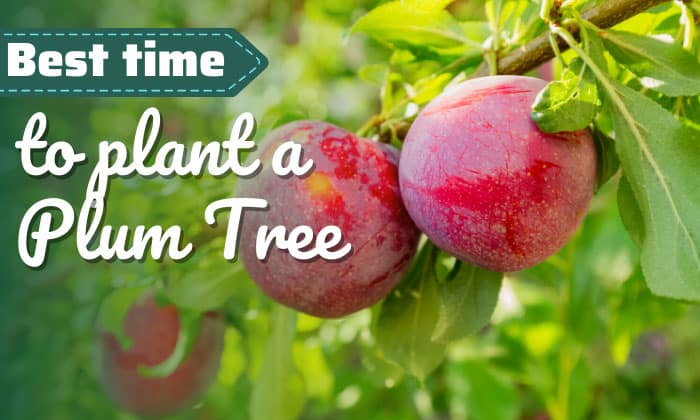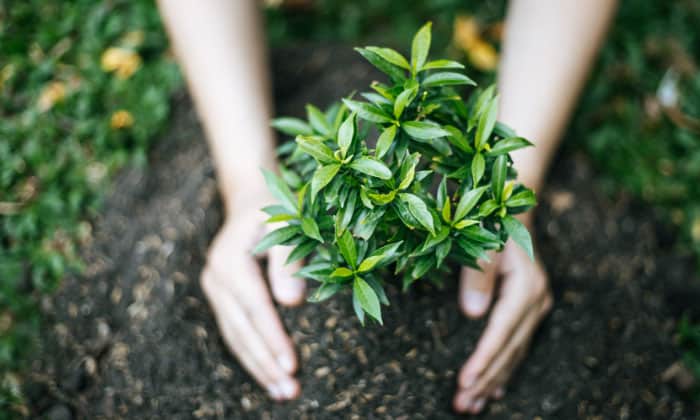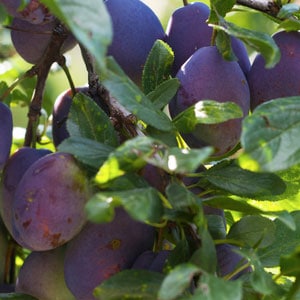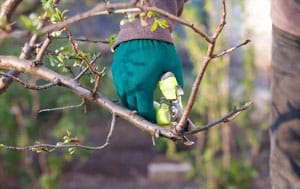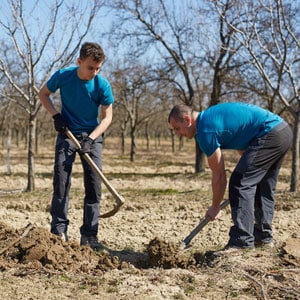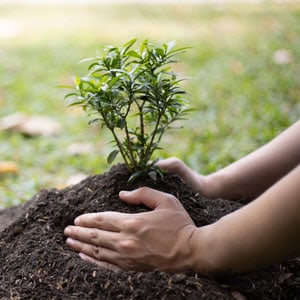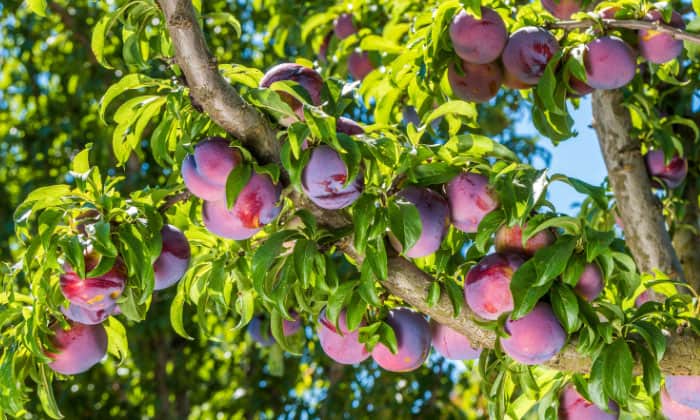Whether fresh or processed, plums are delectable and culinarily versatile. You can eat them raw, toss them into a salad, or make pastry with these stone fruits.
It doesn’t hurt that they contain many vitamins, either, so if you want a new tree in your backyard, growing plums is a thought worth entertaining.
With that said, when is the best time to plant a plum tree? Generally, the right time to grow plums is November to early March, when the trees are still dormant.
Learn how to cultivate them below.
Table of Contents
When to Grow a Plum Tree
Now that you know when to plant plum trees, here are some additional tips to narrow down the best month:
- Grow plums when the ground is tillable. This condition may occur before the last frost, so you don’t need to wait until spring is in full swing to start planting.
For those concerned about cold weather, rest assured that dormant fruit trees are not at risk of frost damage. This is why it’s okay to put them outdoors in late winter or early spring.
In fact, you’ll run into trouble if you wait too long to transplant and new buds have already appeared.
- Interestingly, growing a plum tree in its dormancy lowers chances of root stress. Under this condition, spring temperatures will soon ‘wake’ the plant, giving it plenty of time to establish under mild weather.
- In contrast, fall gardening may come with sudden colds that damage plum trees, so they may not be that healthy once winter arrives. For this reason, it’s unwise to start bare-root plums during autumn.
- One easy way to determine your gardening time is talking to your local nurseries. This method spares you from having to think too much, since nurseries will sell plum trees only when they’re ready for planting.
How to Plant a Plum Tree
What season do plums grow in? The answer is spring, with fall and late summer being the harvest periods. To give your plum tree the best chance of thriving, follow these steps on growing it.
1. Pick your plum variety
There are four types of plums: American, hybrid, Japanese, and European.
- Japanese types do not tolerate low temperatures well, while European and American cultivars are suitable for areas with harsh winters (American plums being slightly better in this aspect).
- As for hybrid types, they combine the positives of Japanese and American trees, producing higher-quality fruits compared to the latter and withstanding frosts better than the former.
Hence, it’s vital to pick the variety that suits your climate. In Texas and Tennessee, for example, Japanese plums like Methley or Satsuma will grow well. Meanwhile, colder states like Iowa and Minnesota require European varieties, such as Mount Royal and Stanley, or hybrid ones like Superior and Alderman.
American plums will also do well in wintry conditions, considering they are hardy down to zone 3. However, these plants don’t have the best fruits for consumption, so they are not very popular.
Climate aside, it’s also important to note that availability matters. American plums and Victoria plum tree, for example, are difficult to acquire, at least in the US.
2. Order saplings
Once you know what plums suit your region, evaluate whether you picked a self-fertile or non-self-fertile variety. For the latter to bear fruits, two trees are necessary, so order your sapling(s) accordingly.
Note that Japanese and American plums are often non-self-fertile, while European ones can pollinate themselves.
3. Prepare the planting area
Before transplanting, put the bare-root tree in a water bucket for six hours. Skip this step if the sapling is planted in a pot.
Should there be a need to delay planting, store the plum under 40 to 59℉ in a dark place or put it in a trench temporarily and cover the roots with soil. Note that trenching is necessary if you can’t garden for over a week.
Once you’re ready to plant, dig a hole six inches deeper than the plum roots. The plot should have loamy, well-drained soil with six hours of direct sunlight at the minimum. For better nutrient retention, mix compost with soil in a 1:2 ratio.
Afterward, lightly rearrange the roots if they are coiled. This step will help you envision how wide you need to dig so that the roots can spread out. You can also add six inches to the diameter of the plant to keep things simple.
4. Plant the plum tree
Put the tree into the center of the hole you dug and backfill it with soil. If there is a graft (which looks like a lumpy scar), keep its union an inch above the soil or six inches above-ground if possible.
At the same time, it’s essential to know how far apart to plant plum trees. This matter is simple enough – just ask the nursery whether you have dwarf or standard plums.
- Dwarf plums are standard varieties grafted onto semi-draft rootstocks; they are smaller, so you can space them 15 feet apart.
- As for standard plums, reserve 25 feet of horizontal space for them.
Once the plants have the correct positions in the ground, press the soil to eliminate excess air and water the roots. And you’re done!
Care for and Harvest Plums
How to take care of plum trees
After planting, follow these tips to care for a plum tree:
- Water the soil at a rate of 0.75 gallon per square foot per week. Double this amount if the garden has poor water retention.
- Mulch the ground with wood chips to improve moisture absorption. Remember to scatter them away from the trunk so that the mulch doesn’t attract rats. Plus, layer no more than four inches of organic matter on top of the soil.
- Nurture plum trees in spring with a balanced, pH-neutral Do this before fruits start to grow and prior to summer.
- Prune in spring for the first year of planting and summer in the subsequent years. Remove all unhealthy, horizontal branches that block sunlight, as well as sprouts below the scaffold limbs. Make 45-degree angle cuts while you trim.
- Plums have a temperature tolerance of around 30 degrees Fahrenheit, depending on how mature they are.
If your tree is flowering, 27 degrees are enough to kill it, while bud-less plants will die at 23 degrees. During winter, cover the trunk and canopy to prevent frost damage.
Harvesting plums
Harvesting plums is easy. Just push or pull the fruit by hand. The stem and the plum should detach from the tree easily.
For branches that are too high to reach, prepare a ladder to stand on. You may also poke the offshoots with a pole or broom and catch fruits using a tarp or net.
Note that the plums should be soft before harvesting is possible.
FAQs
Where is the best place to plant a plum tree?
The location for plum trees should have these attributes:
- A soil pH of 5.5 to 6.5
- South or west-facing to avoid wind damage
- At least eight feet away from water and sewer pipes. If your house has a patio, the tree should have the same distance from it.
- Also, there should be no obstructions that prevent the trees from growing. These include electrical cables, buildings, light fixtures, etc. Reserve a minimum of 16 vertical feet for plum trees, since this is how high they often get.
- If you somehow have multiple semi-dwarf plants, position them 12 feet apart. For big lawn owners, remember not to plant saplings more than 100 feet away from each other, particularly if they need cross-pollination.
How long does it take for a plum tree to yield fruit?
Plum trees often bear fruits within five to ten years. While this may sound disappointing, there’s nothing we can do but wait.
Can you grow plums from a pit?
Plum tree planting from pits is possible. However, you won’t produce plums identical to the mother tree, and chances are there’ll be no or inedible fruits.
Conclusion
When is the best time to plant a plum tree? The answer should be apparent by now.
Grow your saplings in spring, whether you have bare root or container plants. If you forgot to garden early in the year, the only option you have left is summer planting with non-dormant potted plums. These, however, may not do as well as their bare-root counterparts.
Feel free to message us if you have any more questions. Have a nice day!
Read more planting time of other plants:

Hi, I am William – Floridayards’ digital content creator. My job is to find answers to all your concerns with thorough research and our team’s expert advice. I will also bring you honest reviews on the best products and equipment for raising your beautiful garden. Please look forward to our work!


